Laminate-cased battery formed with tab resin adhered to portions of tabs extended from laminate casing
a laminate-cased battery and tab resin technology, applied in the field of laminate-cased batteries, can solve the problems of difficult conventional laminate-cased batteries, and achieve the effect of high energy efficiency and high quality
- Summary
- Abstract
- Description
- Claims
- Application Information
AI Technical Summary
Benefits of technology
Problems solved by technology
Method used
Image
Examples
example
[0073]The laminate-cased battery 1 according to the above-described embodiment is provided as an example. The following are the values of the tab resins 41, 42, 51, and 52.
[0074]Thickness of each of the sheet-shaped components 42a and 42b; 0.06 [mm]
[0075]Extension length of each of the inner tab resins 41 and 42 from the laminate casing 20; 2.0 [mm]
[0076]Thickness of each of the PEN layers 522 and 525 in the sheet-shaped components 52a and 52b; 0.015 [mm]
[0077](Comparison 1)
[0078]As shown in FIG. 6A, a laminate-cased battery according to a comparison 1 is different from the laminate-cased battery 1 according to the above-described embodiment, on the point that the sealed part tab resins 51 and 52 are not inserted. That is, in the laminate-cased battery according to the comparison 1, a tab resin 92 (sheet-shaped components 92a and 92b) having a single-layer structure with modified PP is adhered to a tab 82, and a PP layer 701 of a laminate casing 70 and a tab resin 92 are inserted be...
PUM
 Login to View More
Login to View More Abstract
Description
Claims
Application Information
 Login to View More
Login to View More - R&D
- Intellectual Property
- Life Sciences
- Materials
- Tech Scout
- Unparalleled Data Quality
- Higher Quality Content
- 60% Fewer Hallucinations
Browse by: Latest US Patents, China's latest patents, Technical Efficacy Thesaurus, Application Domain, Technology Topic, Popular Technical Reports.
© 2025 PatSnap. All rights reserved.Legal|Privacy policy|Modern Slavery Act Transparency Statement|Sitemap|About US| Contact US: help@patsnap.com



